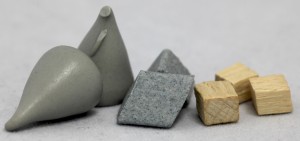
Using different polishing materials, ranging from centimetres to millimetres in size, the cavities are refined in a type of tumbler. Images: DESY/Dirk Nölle
Usually it’s basic research – especially for particle accelerators – that pioneers new technology. But in this case the researchers obviously had a little inspirational snoop at Levi’s or any other jeans manufacturer’s. Recently, DESY’s superconducting TESLA cavities have started to be surface-treated with a stonewashing equipment – accelerators stonewashed, so to say.
While jeans are only stonewashed for show, there is a fundamental scientific background to do this with the 9-cell cavities: in order to reach highest accelerating fields, the inside of the cavities must be as smooth as a mirror. One way to achieve this is to repeatedly polish the interior of the cavities. This treatment is now systematically tested by the ILC HiGrade group. “We want to reach gradients of 35 megavolts per metre and more for the ILC. This requires a surface that is very clean and smooth up to a few nanometres,” said Aliaksandr Navitski, who conducts the testing. For their experiments, the team from of DESY and the University of Hamburg uses a number of cavities especially manufactured for these tests, parallel to the current production of European XFEL cavities.
The stonewashing treatment has four stages. The cavities are filled with different polishing granules and rotate on two axes – a bit like the Earth rotating around the Sun and also around itself – for hours in a type of cement mixer. The first filling, a mixture of stones and water, eliminates impurities that develop mainly locally in the region of the weld of the individual half cells. It removes ten micrometres per hour from the surface. After eight hours, the mixture is exchanged: fine stone granules melted into synthetic material provide an increased degree of fineness. The fine sanding is achieved in the final two stages of stonewashing: the cavity is filled with small hardwood blocks and fine-grained aluminium oxide and water, and in the last stage with colloidal silicon oxide, and mixed for 30 to 40 hours before the highly polished cavity is finished.
“Polishing the inside of a cavity with a mixing machine had already been done at DESY in the 80’s for one-cell PETRA cavities,” said Eckhard Elsen from the FLA group. “However, our current experiments with 9-cell cavities are mainly based on the experience of Fermilab, Jefferson Lab and Japanese colleagues.”
For now, after each “wash cycle”, the cavities are precisely measured in the ILC HiGrade laboratory. “We want to analyse the systematics of stonewashing,” said Navitski. “The evenly distributed filling of the cavity with the appropriate mixture of abrasives and liquid is as important as the tumbling time at each polishing stage.” For the construction of the ILC, this technology could replace the currently used method of electropolishing with fluoric acid. This would not only mean getting rid of the undesirable acid: “The mechanical polishing has the advantage of removing residuals of other metals, e.g. aluminium. This is not possible with electropolishing,” said Navitski.
This article first appeared in DESY inForm.


Recent Comments